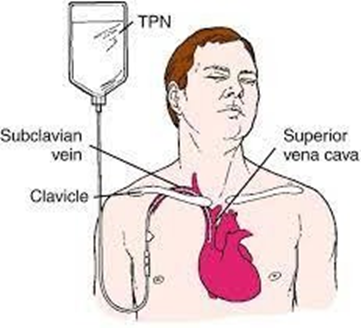A nurse is caring for a client who has a prescription for total parental nutrition (TPN).
Which of the following routes of administration should the nurse use?
Subcutaneous
Intraosseous
Midline catheter
Central venous access device
The Correct Answer is D
Choice A rationale: TPN cannot be administered subcutaneously due to its composition.
Choice B rationale: Intraosseous access is for emergency situations when IV access isn't attainable.
Choice C rationale: A midline catheter might not be suitable for the hypertonic nature of TPN and can lead to complications.
Choice D rationale: Total parenteral nutrition (TPN) is a hypertonic solution that requires infusion into a large vein. The central venous access device allows for high-flow rates and avoids irritation or damage to smaller peripheral veins.

Nursing Test Bank
Naxlex Comprehensive Predictor Exams
Related Questions
Correct Answer is D
Explanation
Choice A rationale: Exophthalmos (bulging eyes) is a characteristic feature of Graves' disease and might not directly relate to the need for a lower medication dose.
Choice B rationale: Weight loss is a symptom of hyperthyroidism and might not directly indicate the need for a lower methimazole dose.
Choice C rationale: Diaphoresis (excessive sweating) can be a symptom of hyperthyroidism but might not solely indicate the need for a lower methimazole dose.
Choice D rationale: Bradycardia (abnormally slow heart rate) might indicate excessive suppression of thyroid function caused by an excessive dose of methimazole in a client with Graves' disease, warranting a lower medication dose.
Correct Answer is D
Explanation
Choice A rationale: Montelukast is a leukotriene receptor antagonist and doesn't directly interact with albuterol.
Choice B rationale: Pantoprazole is a proton pump inhibitor and does not directly interact with albuterol.
Choice C rationale: Isosorbide mononitrate is a nitrate used for heart conditions and does not directly interact with albuterol.
Choice D rationale: Albuterol, used for asthma, is a beta-agonist, while propranolol is a beta-blocker. Administering these medications together can counteract the effects of both drugs due to their opposing actions on beta receptors. It's crucial to withhold propranolol and inform the provider to avoid potential adverse effects.
Whether you are a student looking to ace your exams or a practicing nurse seeking to enhance your expertise , our nursing education contents will empower you with the confidence and competence to make a difference in the lives of patients and become a respected leader in the healthcare field.
Visit Naxlex, invest in your future and unlock endless possibilities with our unparalleled nursing education contents today
Report Wrong Answer on the Current Question
Do you disagree with the answer? If yes, what is your expected answer? Explain.
Kindly be descriptive with the issue you are facing.
